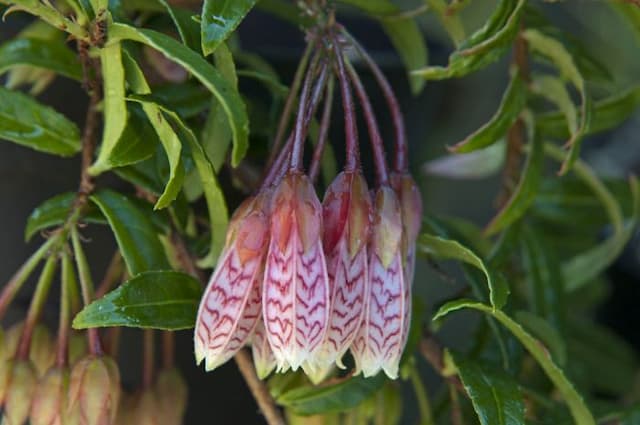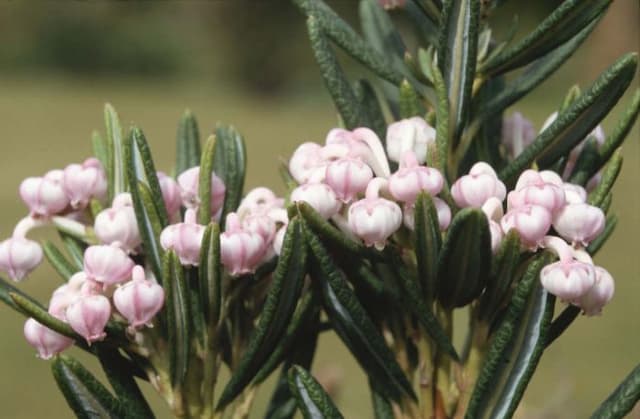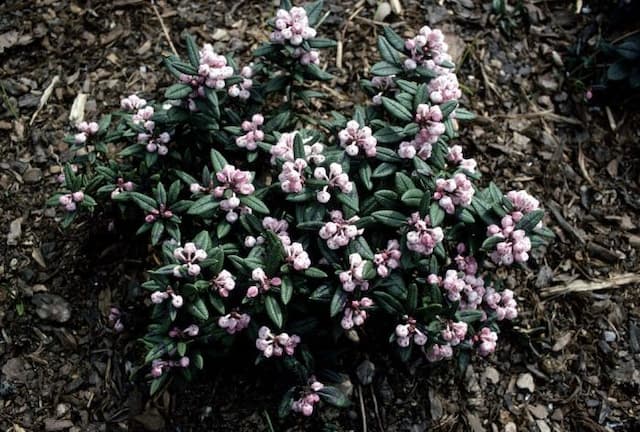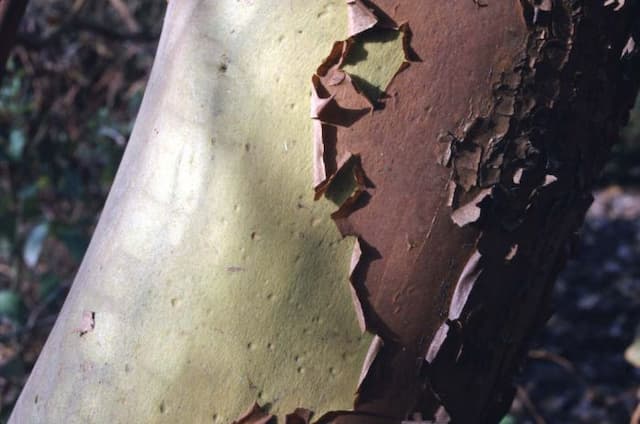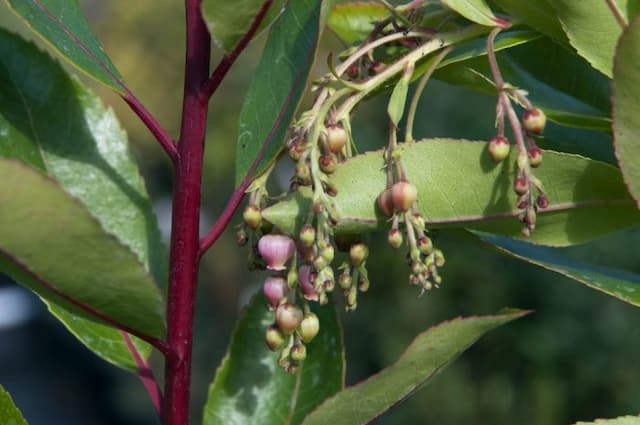Rhododendron Rhododendron 'Vintage Rosé'

ABOUT
The Rhododendron 'Vintage Rosé' is a captivating shrub known for its stunning flowers and lush foliage. This particular variety boasts blossoms that are of a delicate pink shade, reminiscent of aged rose wine. Its flowers feature a wavy edge, adding a touch of elegance and visual depth to the overall appearance. They typically cluster together to form a rounded truss, creating a full and abundant floral display. The leaves of 'Vintage Rosé' are equally attractive, with a deep green color that provides a perfect backdrop for the lighter-hued flowers. Their surface is glossy, reflecting light and adding a vibrant quality to the plant. The foliage tends to be evergreen, ensuring year-round interest in the garden or landscape where it is planted. Depending on the season, the Rhododendron 'Vintage Rosé' can also show different attributes. In the cooler part of the year, the leaves might take on a slightly bronzed tone, whilst the buds for the upcoming blossoms present a promise of the beauty that will unfold with warmer weather. Overall, the Rhododendron 'Vintage Rosé' is a plant that offers both a striking floral display and a rich tapestry of foliage, making it a favorite among gardeners seeking to add charm and color to their outdoor spaces.
About this plant
 Names
NamesSynonyms
Vintage Rosé Rhododendron, Vintage Rosé Azalea
Common names
Rhododendron 'Vintage Rosé'
 Toxicity
ToxicityTo humans
Rhododendrons, including 'Vintage Rosé', contain toxic compounds that can be harmful to humans if ingested. All parts of the plant are considered poisonous, including the leaves, nectar, and pollen. The toxic principle is grayanotoxin, which can disrupt sodium channels affecting the skeletal and cardiac muscles, as well as nerve function. Symptoms of poisoning may include vomiting, diarrhea, hypersalivation, weakness, coma, hypotension, CNS depression, cardiovascular collapse, and potentially death if a significant enough quantity is consumed.
To pets
Rhododendrons, including the 'Vintage Rosé' variety, are toxic to pets, especially cats, dogs, and horses. The entire plant, including leaves and flowers, contains compounds known as grayanotoxins. When ingested by pets, symptoms may include vomiting, diarrhea, drooling, weakness, lack of coordination, abdominal pain, muscle tremors, cardiac problems, and in severe cases, coma or death. Early veterinary intervention is crucial to manage toxicity symptoms in pets effectively.
 Characteristics
CharacteristicsLife cycle
Perennials
Foliage type
Evergreen
Color of leaves
Green
Flower color
Pink
Height
4-5 feet (1.2-1.5 meters)
Spread
4-6 feet (1.2-1.8 meters)
Plant type
Shrub
Hardiness zones
5-8
Native area
Asia
Benefits
 General Benefits
General Benefits- Aesthetic Appeal: The Rhododendron 'Vintage Rosé' adds visual interest to gardens with its unique rose-colored blooms and lush evergreen foliage.
- Seasonal Interest: It typically flowers in spring, providing a seasonal display of color when many other plants have yet to bloom.
- Wildlife Attraction: The blossoms can attract pollinators such as bees and butterflies, thus promoting biodiversity in the garden.
- Erosion Control: As an evergreen shrub with a substantial root system, it can help prevent soil erosion in sloped areas or where ground stability is a concern.
- Low Maintenance: Once established, Rhododendrons require minimal care, making them a low-maintenance option for gardeners.
- Drought Tolerance: Some Rhododendron varieties, including 'Vintage Rosé', can tolerate periods of dryness once fully established.
- Versatility: It can be used in various landscape designs, from formal to cottage gardens, borders, and foundation plantings.
- Privacy Screening: With its dense growth habit, it can be used to create natural privacy screens or hedges.
 Medical Properties
Medical PropertiesThis plant is not used for medical purposes.
 Air-purifying Qualities
Air-purifying QualitiesThis plant is not specifically known for air purifying qualities.
 Other Uses
Other Uses- Rhododendrons can be used for creating natural dyes. The flowers of Rhododendron 'Vintage Rosé' may be boiled to extract color for use in dying textiles or paper products.
- The plant can serve as a privacy screen or natural border when planted in a row due to its dense foliage and large size.
- Rhododendrons are commonly used in bonsai cultivation for enthusiasts looking to shape and train plants in miniature form.
- Because of their toxicity, Rhododendron 'Vintage Rosé' can be planted to deter wild animals, such as deer, from nibbling on garden plants.
- The thick leaves can be used to create a natural mulch, which helps retain soil moisture and prevent weed growth.
- The woody stems of mature rhododendrons can be repurposed into rustic crafts, such as walking sticks or decorative garden stakes.
- Known for their vibrant blooms, Rhododendron 'Vintage Rosé' flowers can be used as a natural pigment in art projects, similar to traditional plant-based pigments.
- In some cultures, the leaves are used to prepare a ceremonial smudge that is believed to carry protective properties.
- The acidic nature of dropped rhododendron leaves can be utilized to naturally alter the pH of soil in gardens requiring more acidic conditions.
- Rhododendron thickets provide shelter and nesting sites for many species of birds and beneficial insects, promoting local biodiversity.
Interesting Facts
 Feng Shui
Feng ShuiRhododendron can be used in Feng Shui to enhance the Wood element due to its lush greenery, which is beneficial for growth and vitality. It should be placed in the East sector of a garden or the Wealth area of a home to foster abundance.
 Zodiac Sign Compitability
Zodiac Sign CompitabilityThe Rhododendron is not used in astrology practice.
 Plant Symbolism
Plant Symbolism- Caution: The rhododendron plant is often associated with caution due to its toxic nature, which can be harmful if ingested.
- Beware: In some cultures, rhododendrons are seen as a sign to be cautious or beware, again referencing the plant’s poisonous characteristics.
- Agility: The rhododendron has been linked to agility, possibly because it thrives on rugged, mountainous terrain.
- Abundance: With their full, lavish blooms, rhododendrons can symbolize abundance or wealth.
- Homecoming: In some regions, the rhododendron is a signal of returning or coming home, often because these plants are common in particular areas.
 Water
WaterRhododendrons, including the 'Vintage Rosé' variety, require consistent moisture, so it's important to keep the soil evenly moist but not soggy. Water the plant with about 1 inch of water once a week during the growing season, and adjust according to rainfall, more often if conditions are very dry, less if it's rainy. During the winter, reduce watering but don't allow the roots to dry out completely. Always use a gentle stream of water directly at the base of the plant to avoid wetting the foliage, which can promote disease. For a medium-sized rhododendron, this might translate to about 1-2 gallons of water per week, though this can vary based on soil type and climate.
 Light
LightRhododendron 'Vintage Rosé' prefers partially shaded conditions with dappled sunlight or morning sun and afternoon shade. The best spot for this plant would be an area that avoids the intense heat of the midday sun, which can scorch the leaves. An ideal location might be under the light canopy of tall trees or on the east side of a building, where it receives protection from harsh afternoon light.
 Temperature
TemperatureThe 'Vintage Rosé' rhododendron thrives in temperatures that are generally moderate, preferring a range between 40°F and 75°F for optimal growth. However, it is able to withstand temperatures as low as 20°F and as high as 80°F. It's important to protect the plant from strong winter winds and heavy frost that can damage the buds and leaves, as well as from extreme summer heat which can cause stress.
 Pruning
PruningPrune the 'Vintage Rosé' rhododendron in late winter or early spring, before new growth starts. Pruning is used to maintain the shape of the plant, remove dead or diseased wood, and encourage branching. It's typically done once a year, but it can be skipped if the plant maintains a good shape on its own. The best time for pruning is after the blooms have faded but before the new bud set.
 Cleaning
CleaningAs needed
 Soil
SoilThe best soil mix for Azalea 'Vintage Rosé' should be well-draining, high in organic matter, and have an acidic pH between 4.5 to 6.0. A mixture of 50% peat moss or pine bark, 40% perlite, and 10% compost will create an ideal environment for root growth and health.
 Repotting
RepottingAzalea 'Vintage Rosé' typically needs repotting every 2 to 3 years. They should be repotted in the spring just as new growth begins to ensure they have room to expand and thrive in the upcoming growing season.
 Humidity & Misting
Humidity & MistingAzalea 'Vintage Rosé' thrives best in moderate to high humidity levels, around 50-60%. If indoor air is dry, use a humidifier or a pebble tray filled with water beneath the pot to increase humidity.
 Suitable locations
Suitable locationsIndoor
Provide bright, indirect sunlight and maintain high humidity.
Outdoor
Plant in partial shade with well-draining acidic soil.
Hardiness zone
5-8 USDA
 Life cycle
Life cycleThe life cycle of the Rhododendron 'Vintage Rosé', commonly known as Azalea, begins with seed germination, which occurs in a moist, well-drained environment, typically in the spring. After germination, the seedling goes through a juvenile phase, where it develops into a young plant with characteristic leaves and begins to establish a root system. The plant then enters a vegetative growth phase, where it matures and grows larger each year, developing woody stems and a fuller shape. Once mature, the Azalea starts its reproductive phase, producing buds that bloom into its distinctive pink flowers, usually in the spring. After the flowering phase, the plant sets seed, which, when dispersed, have the potential to grow into new Azalea plants, continuing the cycle. Throughout its life, this perennial shrub may undergo periods of dormancy, particularly in colder climates, where it conserves energy during the winter months before resuming growth in the spring.
 Propogation
PropogationPropogation time
Spring to early summer
The most common method for propagating Rhododendron 'Vintage Rosé', which is known generally as a rhododendron, is through semi-hardwood cuttings. This process typically takes place during the late summer. The appropriate way to propagate using this method involves selecting a healthy stem of the current year's growth and cutting a 4 to 6-inch section, ensuring there are at least two sets of leaves on the cutting. The bottom set of leaves is removed, and the cut end can be dipped in a rooting hormone for better success. Then, the cutting is placed in a pot with well-draining soil, watered thoroughly, and covered with a plastic bag or placed in a greenhouse to maintain high humidity. Roots usually form in a span of several weeks to a few months, after which the new plant can be gradually acclimated to less humid conditions before planting out.
